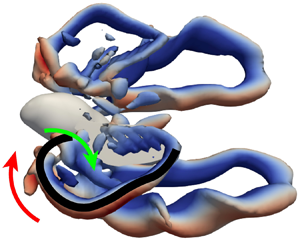Crossref Citations
This article has been cited by the following publications. This list is generated based on data provided by
Crossref.
CAI, Xuefei
and
LIU, Hao
2021.
A six-degree-of-freedom proportional-derivative control strategy for bumblebee flight stabilization.
Journal of Biomechanical Science and Engineering,
Vol. 16,
Issue. 4,
p.
21-00113.
Cai, Xuefei
Xue, Yujing
Kolomenskiy, Dmitry
Xu, Ru
and
Liu, Hao
2022.
Elastic storage enables robustness of flapping wing dynamics.
Bioinspiration & Biomimetics,
Vol. 17,
Issue. 4,
p.
045003.
van Veen, Wouter G.
van Leeuwen, Johan L.
van Oudheusden, Bas W.
and
Muijres, Florian T.
2022.
The unsteady aerodynamics of insect wings with rotational stroke accelerations, a systematic numerical study.
Journal of Fluid Mechanics,
Vol. 936,
Issue. ,
Ji, Tingwei
Jin, Fan
Xie, Fangfang
Zheng, Hongyu
Zhang, Xinshuai
and
Zheng, Yao
2022.
Active learning of tandem flapping wings at optimizing propulsion performance.
Physics of Fluids,
Vol. 34,
Issue. 4,
Tong, Wenwen
Wang, Shizhao
and
Yang, Yue
2022.
Estimating forces from cross-sectional data in the wake of flows past a plate using theoretical and data-driven models.
Physics of Fluids,
Vol. 34,
Issue. 11,
Xue, Yujing
Cai, Xuefei
and
Liu, Hao
2022.
Effects of wing–body interaction on hawk moth aerodynamics and energetics at various flight velocities.
Physics of Fluids,
Vol. 34,
Issue. 5,
Sun, Wei
Yu, Jingjun
He, Guangping
and
Cai, Yueri
2022.
Study on Transmission Mechanism and Flexible Flapping Wings of an Underactuated Flapping Wing Robot.
Journal of Intelligent & Robotic Systems,
Vol. 104,
Issue. 2,
Calado, Andre
Poletti, Romain
Koloszar, Lilla K.
and
Mendez, Miguel A.
2023.
A robust data-driven model for flapping aerodynamics under different hovering kinematics.
Physics of Fluids,
Vol. 35,
Issue. 4,
Anusonti-Inthra, Phuriwat
2023.
Data-Driven Modeling of Aerodynamic Loadings for Tiltrotor Pylon using Multi-Fidelity CFD Data.
Sun, Weizhen
He, Guoyi
Wang, Qi
and
Yu, Feng
2023.
Numerical Study and Parameter Prediction in Hydrodynamic Performance of Self-Propelled Wiggling Hydrofoils.
IEEE Access,
Vol. 11,
Issue. ,
p.
139187.
Corban, Baptiste
Bauerheim, Michael
and
Jardin, Thierry
2023.
Discovering optimal flapping wing kinematics using active deep learning.
Journal of Fluid Mechanics,
Vol. 974,
Issue. ,
Xue, Yujing
Cai, Xuefei
Xu, Ru
and
Liu, Hao
2023.
Wing Kinematics-Based Flight Control Strategy in Insect-Inspired Flight Systems: Deep Reinforcement Learning Gives Solutions and Inspires Controller Design in Flapping MAVs.
Biomimetics,
Vol. 8,
Issue. 3,
p.
295.
Du, Feng
and
Wu, Jianghao
2023.
Analytical Modeling for Flapping Wing Deformation and Kinematics with Beam Flexibility.
AIAA Journal,
Vol. 61,
Issue. 2,
p.
875.
Lauer, Jessy
2023.
Video-driven simulation of lower limb mechanical loading during aquatic exercises.
Journal of Biomechanics,
Vol. 152,
Issue. ,
p.
111576.
Poletti, Romain
Calado, Andre
Koloszar, Lilla K.
Degroote, Joris
and
Mendez, Miguel A.
2024.
On the unsteady aerodynamics of flapping wings under dynamic hovering kinematics.
Physics of Fluids,
Vol. 36,
Issue. 8,
Xue, Yujing
Cai, Xuefei
and
Liu, Hao
2024.
Aerodynamics and stability of hawkmoth forward flight with flexible wing hinge.
Physical Review Fluids,
Vol. 9,
Issue. 6,
WANG, Tianqi
LIU, Liu
LI, Jun
and
ZENG, Lifang
2024.
Time-history performance optimization of flapping wing motion using a deep learning based prediction model.
Chinese Journal of Aeronautics,
Vol. 37,
Issue. 5,
p.
317.
Ahmed, Farhanuddin
कलभावी वधि राज
and
Arora, Nipun
2024.
A kinematic analysis of flow dynamics and aerodynamic performance in the clap-and-fling motion.
Physics of Fluids,
Vol. 36,
Issue. 10,
Liu, Hao
Wang, Shizhao
and
Liu, Tianshu
2024.
Vortices and Forces in Biological Flight: Insects, Birds, and Bats.
Annual Review of Fluid Mechanics,
Vol. 56,
Issue. 1,
p.
147.
Singh, Balbir
Ahmad, Kamarul Arifin
Murugaiah, Manikandan
Yidris, Noorfaizal
Basri, Adi Azriff
and
Pai, Raghuvir
2024.
Quasi-steady aerodynamic modeling and dynamic stability of mosquito-inspired flapping wing pico aerial vehicle.
Frontiers in Robotics and AI,
Vol. 11,
Issue. ,
